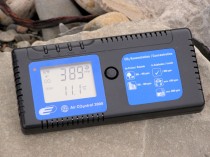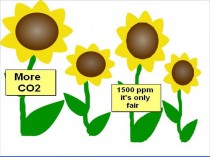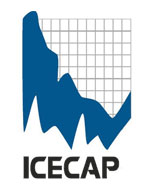By Larry Bell, Forbes
We have met the enemy, and yup, it is us. No doubt about it. The planet is on fire and we’re obviously to blame. Why else would the Department of Defense have to release a February 2010 Quadrennial Defense Review (QDR) declaring that climate change will play a “significant role in shaping the future security environment"- and cause a “...need to adjust to the impacts of climate change on our facilities and military capabilities”? The QDR warns that this climate change threat “...may act as an accelerant of instability or conflict, placing a burden to respond on civilian institutions and militaries around the world”.
Gosh, does that mean they may have to attack everyone? Maybe not. Since government bureaucrats aren’t mentioned, they’re probably exempt.
And it’s not like we haven’ t been warned about this security threat before. Some of you may possibly remember an April 2008 Time magazine cover feature that drew a direct parallel between the current battle against climate change and U.S. involvement in World War II against Nazi Germany and Japan. Here, the famous image of five American Marines raising a flag at Iwo Jima following a terrible 35-day conflict that killed sixty-eight hundred of our troops was modified to depict the Marines planting a tree. The caption read “How to Win the War on Global Warming.” Some of us then took serious offense at that correlation. Some of us still do.
A television commercial produced by the Alliance for Climate Protection (ACP) founded by Al Gore in 2006 showed footage of American soldiers storming beaches at Normandy during WWII, a civil rights march, and a moon landing, linking these historic events to an urgent need for action now. William H. Macy narrated the message, stating “We can’t wait for someone else to solve the climate crisis. We need to act, and we need to act now. Join us. Together we can solve the climate crisis.”
In 2007, Senate Armed Services Committee members Hillary Clinton (D-NY) and John Warner (R-VA) snuck some language into the National Defense Authorization Act which got our military into the climate protection business whether they wanted to or not. The amendment required DoD to consider the effects of climate change upon their facilities, capabilities and missions. Now, through the QDR, the DoD is incorporating and considering the “threat” of climate change into its long-range strategic plans. This despite the fact that no evidence of a climate crisis, much less any human-caused one, actually exists.
And exactly what U.S. national security threats are they worried about anyway? One that security planners highlighted in 2009 revolves around concern that global warming will melt the massive Himalayan ice mass. In theory, that will cause rivers fed by Himalayan glaciers to flood first, then will dry up once the glaciers retreat, endangering tens of millions of people in lowland Bangladesh. Retired Air Marshal A.K. Singh, a former commander in India’s air force, then foresaw resulting mass migrations across national borders, with militaries (including ours) becoming involved.
This dire Himalayan glacier calamity was predicted by a preeminent international climate science organization, none other than the United Nations Intergovernmental Panel on Climate Change (IPCC). Who could doubt their competence and veracity? Well, actually, many scientists have good reasons to do so. And in this instance it turned out, and the IPCC later admitted, that the Himalayan prediction was completely fabricated with absolutely no supporting science by a fellow who worked for the IPCC’s director. Seems like top Pentagon officials can sleep better knowing this, provided of course, that someone informed them.
According to Under Secretary of Defense for Policy Michele Flournoy , “The QDR may be the most important report DoD provides Congress. It really requires the department to step back and think strategically about the present and the future to set its priorities and objectives and then to connect those to the program and to the budget” (Read this to mean that it ain’t going to be cheap!)
The QDR climate change response strategy includes provisions to “...investigate alternative concepts for improving operational energy use”...and increase use of renewable energy supplies and reduce energy demand to “improve operational effectiveness, reduce greenhouse gas emissions in support of U.S. climate change initiatives, and protect the Department from energy price fluctuations.” So let’s look at an existing example that applies these directives.
The U.S. Air Force is supporting development of the largest North American solar plant to provide electricity for the Nellis Air Force Base located outside Las Vegas which covers 140 acres of the Nevada desert with massive photovoltaic arrays that track the sun. The facility is capable of producing 15 MW of power, enough to cover about 30% of Nellis requirements. As advertised, the Air Force expects to save $1 million per year in power costs. In fact the Air Force is so pleased with the project that it hopes to double the power it gets from solar in the near future. Sounds pretty good so far doesn’t it?
The down side is that these current and future cost savings are only possible thanks to multimillion-dollar federal and state financial subsidies and incentives. “Without those, prices wouldn’t be competitive,” according to Daniel Tomlinson, editor of a solar newsletter for Navigant Consulting.
The Nellis project was developed through a complex arrangement between the Air Force and financial partners where power providers covered system construction costs in return for a guaranteed market along with substantial federal tax subsidies and other incentives. For example, MMA Renewable Ventures and its investors enjoy a 30% tax credit, have the benefit of accelerated capital depreciation schedules, and sell solar energy credits generated by the project to NV Energy, which must obtain 20% of its power from renewable sources by 2015.
So there you have it. Our country’s Air Force (that is, the U.S. Government) is saving about $1 million a year because the same U.S. Government is providing many tens of millions of dollars in tax incentives, in combination with generous contributions in the form of higher electricity prices charged to Nevada customers. Just think of all the money the government is saving us!
But caution: don’t attempt this stunt at home. Posted with permission of author.
FOR IMMEDIATE RELEASE
Tuesday, May 31, 2011
Contacts:
Christopher Horner, chris.horner@atinstitute.org
Paul Chesser, paul.chesser@atinstitute.org
American Tradition Institute’s Environmental Law Center has learned that George Mason University, in response to a Freedom of Information Act (FOIA) request from USA Today, promptly released an academic’s correspondence and related records of the same class as those sought by ATI from the University of Virginia regarding former assistant professor Michael Mann. This provides a new complication for UVAís argument that its delay and withholding of records are consistent with practice and the Commonwealth’s FOI Act, regarding ATI’s long-stalled (more than 4 Ĺ months) request.
The distinctions between how these two universities responded are inescapable, and paint UVAís continued reticence in a very bad light. First, in response to requests for records of like kind and quality, one state institution - GMU - promptly and cooperatively executed its obligations under FOIA, providing approximately 3,000 pages of responsive records to USA Today within 14 days, without charge. Meanwhile the other, UVA, failed to produce records for months; refused to abide by a reasonable production schedule; claimed exemptions in the FOIA law that do not apply to Mann’s case; and imposed on ATI a financial hurdle of thousands of dollars. UVA only started providing records after ATI sued for compliance.
Second, the subject of the request to UVA, Michael Mann, is a leading voice in the global warming grant-seeking and policy advocacy industry. In contrast the subject of the GMU request is Edward Wegman, who co-authored a report at Congress’s request that exposed the statistical methods employed (and ignored) by Mann, et al. The report also revealed how a small group of related professionals have turned peer-review in climate science into an almost meaningless and sometimes perverse “pal review.”
ATI learned of this troubling disparity through another request for records, after a review of national news stories that addressed Wegman’s records. Unlike ATI’s FOIA, the GMU inquiry prompted no outcry from groups such as the ACLU, American Association of University Professors (AAUP), and American Association for the Advancement of Science (AAAS), all which claimed to be outraged out of principle at the prospect of the release of similar records for Mann.
ATI requested from GMU copies of potential correspondence from ACLU, AAUP, or AAAS regarding the Wegman case, to determine whether the activist groups had lodged similar complaints about the release of Wegman’s records. GMU informed ATI that no such records existed.
“All of this affirms the hypocrisy of claimed outrage over the application of Virginia’s FOIA to the records we seek from UVA,” said Christopher Horner, director of litigation for ATI’s Environmental Law Center. “Obviously UVA and these intervening groups believe FOIA is uniquely designed to allow the selective shielding of records, ones the global warming industry deems ad hoc must be kept from the public at all costs.”
After an inquiry by a Washington Post editorial writer, ATI fully briefed him on the law’s letter, spirit and typical implementation as evidenced by GMU’s records release - and that no activists took issue with that Virginia university releasing the records of the less politically correct. But the Post had no interest in the relevant facts, or in their own double standard, as was illustrated in an editorial published on Memorial Day in which the newspaper criticized ATI’s supposed “misuse” of FOIA and “harassment” of climate change researchers.
Last week ATI’s request for Mann’s records went before a Prince William County judge, who ordered that UVA provide the taxpayer-underwritten records to ATI in electronic form within 90 days. In addition ATI has won the right, under a protective order, to look at all the documents beginning no later than September 21, including those the University refuses to make public via claimed exemptions.
“Our claim is about nothing more than execution of the FOIA law as written, and as it has been applied elsewhere,” said David Schnare, director of ATIís Environmental Law Center. “UVA must soon defend its decision to keep the public in the dark. It may want to take a hard look at what GMU released as they set one standard of performance the public now expects UVA to meet.”
To view all documents and media coverage of ATI v. University of Virginia, visit ATI’s special Law Center page for the case.
For an interview with American Tradition Institute senior director of litigation Christopher Horner, email chris.horner@atinstitute.org or call (202)670-2680.
By Ric Moran, American Thinker
The only reason I am highlighting this piece in the Guardian is because it is a textbook example of everything that’s wrong with climate change advocates.
Greenhouse gas emissions increased by a record amount last year, to the highest carbon output in history, putting hopes of holding global warming to safe levels all but out of reach, according to unpublished estimates from the International Energy Agency.
The shock rise means the goal of preventing a temperature rise of more than 2 degrees Celsius - which scientists say is the threshold for potentially “dangerous climate change” - is likely to be just “a nice Utopia”, according to Fatih Birol, chief economist of the IEA. It also shows the most serious global recession for 80 years has had only a minimal effect on emissions, contrary to some predictions.
Last year, a record 30.6 gigatonnes of carbon dioxide poured into the atmosphere, mainly from burning fossil fuel - a rise of 1.6Gt on 2009, according to estimates from the IEA regarded as the gold standard for emissions data.
“I am very worried. This is the worst news on emissions,” Birol told the Guardian. “It is becoming extremely challenging to remain below 2 degrees. The prospect is getting bleaker. That is what the numbers say.”
Professor Lord Stern of the London School of Economics, the author of the influential Stern Report into the economics of climate change for the Treasury in 2006, warned that if the pattern continued, the results would be dire. “These figures indicate that [emissions] are now close to being back on a ‘business as usual’ path. According to the [Intergovernmental Panel on Climate Change’s] projections, such a path ... would mean around a 50% chance of a rise in global average temperature of more than 4C by 2100,” he said.
1. Absolutely no quoting of skeptics.
2. Warnings of absolute catastrophe with not a shred of evidence to support it.
3. Hiding the fact that the increase in CO2 comes from “developing countries” (China, India) and not from the industrialized world. (one passing reference)
4. A 50-50 chance of a 4c rise in temps by 2100? Talk about hedging your bets!
5. Ascribing reliable authority to people and organizations that have no track record of accuracy whatsoever.
6. The usual picture of smoking industrial smokestacks when CO2 is invisible and is not a pollutant.
I’m sure you could add more to the list. But since most of the increase comes from non-signatories to Kyoto and Copenhagen, it is unclear exactly why western industrialized countries should reduce their emissions even further, damaging their economies in the process, while China and India get a free ride.
Scare tactics don’t work anymore. Quoting biased scientists and organizations who parrot echo chamber pronouncements of doom and gloom is just not good enough anymore. What models predict a 4c rise in temps before 2100? How accurate have they been to this point? Why the arbitrary number of 22GT’s of emissions to prevent a rise in temps? Where does it come from? Who figured it out? Why not 23GT’s of emissions? Or 24?
A good scientist - and a discerning reader of science articles in the mainstream press - demand answers to those and other questions before getting on the sky is falling bandwagon. Before we mangle the economies of the western world to satisfy the Luddites and control freaks in the UN, the NGO’s and the radical green movement, we should require more proof than these ridiculous attempts at scaremongering by the media and their allies in the Global Warming movement.
We are told CO2 at 390 ppm is dangerous to our health and our future. What is the reality? Certainly not as warmists project. We breathe out air with 40,000 ppm CO2 - one hundred times the ambient concentration. Since the post World War II Industrial Revolution began in 1947, CO2 has risen but temperatures fell from 1947 to 1978 then rose until 1998 before levelling off and falling since 1998. That means 4 decades of cooling versus two decades of warming. Not a strong endorsement for the so called consensus view.
Also as this instrument to measure CO2 notes, CO2 levels are not uniform. In cities they can range to 600 ppm, inside homes to 800 ppm, inside classrooms and hearing rooms where our government plots to take your money through carbon regulation, 1500 ppm and inside factories perhaps 5000 ppm. Inside submarines, levels of 6000 to as high as 11,000 are reported without any ill effects. Plants have been shown to thrive at CO2 levels 3 to 4 times the ambient. Many nurseries pump in CO2 into greenhouses.


Studies that claim climate change is impacting crop yields negatively are based on models and not reality. It shows you how far the warmists are willing to go to keep the gravy train of money (now over $106 billion and counting) on the track.


